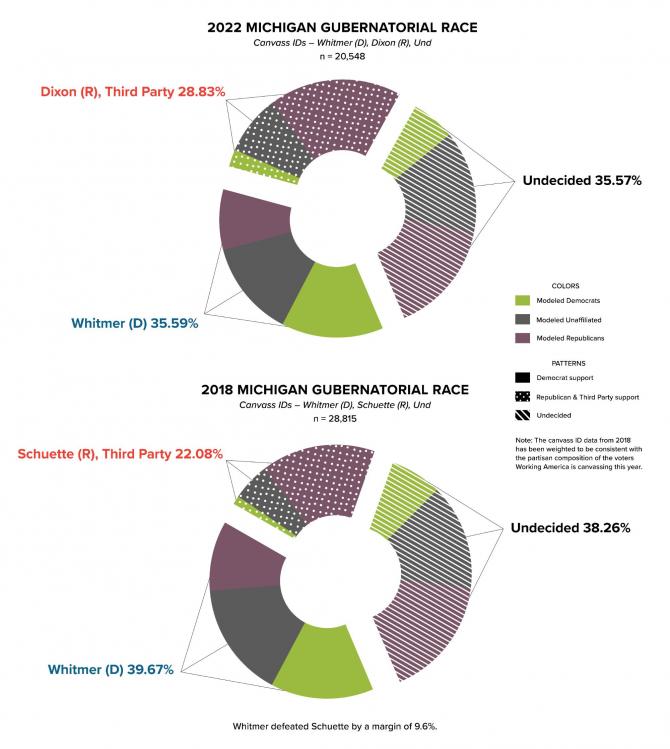Chip in Now to Stand Up for Working People
Working people need a voice more than ever and Working America is making that happen.
Working people need a voice more than ever and Working America is making that happen.
Matt Morrison
10/03/2022
Today, Working America canvassers will have over 10,000 face-to-face conversations with voters in the closest battleground states and districts in the country. Tomorrow, we will do it again, as we will every day from now until the election.
Listening to voters at this scale and over the years gives us a unique insight into what’s really going on behind the headlines. We will be sharing regular updates about what we’ve learned from now until the election.
First up is Michigan, where Gov. Gretchen Whitmer is given a 93% chance of winning reelection by some experts. We share the enthusiasm, but see reason for a more cautious assessment as Whitmer loses support among unaffiliated voters and others.


Comparing Whitmer’s support this year to what we heard in 2018 conversations, she is running 4 points behind her own earlier pace. Republican Tudor Dixon is running 6.5 points ahead of her 2018 counterpart Bill Shuette.
In both 2018 and 2022, our Michigan canvass data comes from largely swing suburban regions of Detroit in Wayne, Oakland and Macomb counties. Given that Whitmer ultimately enjoyed a nearly 10-point win in 2018, some tightening in our data is both expected and tolerable.
But no candidate’s supporters are monolithic. The data above groups voters from both years by their choice in the horse race — Whitmer (D), Dixon/Shuette (R) and undecided — by pattern. For each voter, we then look at their partisan identity — likely Democrats, Republicans and unaffiliated — by color.
In Whitmer’s case, we see that her lower numbers are a result of diminished support from unaffiliated and likely GOP voters. Those unaffiliated voters appear to have moved over to Dixon.
Meanwhile, Dixon has also gained support from some likely Democrats and consolidated support from the likely GOP voters. Put another way, Dixon is broadly more popular than her GOP predecessor, while Whitmer’s appeal has narrowed to be more dependent on the Democratic base. Click here to see the numbers.
Looking at the data this way is critical to Working America’s approach. Unlike many progressive groups that aim primarily to turn out likely Democratic voters, our canvassers focus on persuasion contacts across the range of historically likely voters.
These conversations help voters connect the issues they care about to the candidates who support them. We have ongoing contact with most of these voters across multiple elections.
Based on randomized control trials, Working America’s canvassing is adding between 1,000 and 2,000 new Democratic votes per day, every day, nationwide between now and Election Day in critical gubernatorial and Senate races in swing states across the country.
(NOTE: While there are also efforts underway to change the electorate by turning out more likely Democratic voters, 2018 was, historically speaking, a high water mark for Democratic turnout in a midterm. Democrats and their allies will need to work hard to achieve those turnout levels again in 2022.)
By talking (and listening) to 20,000 Michigan voters already this year, we not only understand which types of voters are shifting, but also the mood shaping the landscape.
In future updates, we will dive into other states — Arizona, Georgia, Pennsylvania, and others — adding analysis of the race, observations about the voters, and impacts of our organizing. As always, thank you for your support of Working America.
See you on the doors,
Matt Morrison
We use cookies and other tracking technologies on our website. Examples of uses are to enable to improve your browsing experience on our website and show you content that is relevant to you.